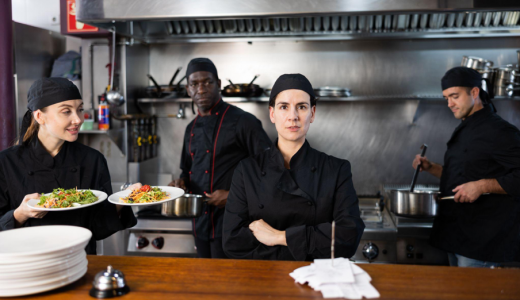
In the culinary world, leadership is the secret ingredient that transforms good kitchens into great ones. Yet, even in the most prestigious kitchens, leadership gaps can emerge, creating challenges that, if left unaddressed, can spoil the recipe for success. Identifying and addressing these gaps is akin to troubleshooting a complex dish that’s not quite right, requiring insight, experience, and a proactive approach. Let’s explore how leadership gaps manifest in a professional kitchen and outline strategies to fill them, ensuring the continued success and growth of culinary ventures.
Recognizing the Signs of Leadership Gaps
- No Ownership on the Line: Much like a dish missing its key ingredient, a kitchen can suffer when no one takes full ownership of their responsibilities. Leadership gaps here mean unresolved problems and a lack of initiative to deliver consistent quality.
- Unmet Culinary Expectations: When the outcome on the plate doesn’t match the vision in the recipe, there’s a gap. Clear communication of expectations and regular feedback are essential ingredients in aligning the kitchen team’s efforts with the culinary goals.
- Unprepared Sous-Chefs: The future of any kitchen rests on the shoulders of its emerging leaders. Preparing them through mentorship, continuous learning, and practical experience is critical, much like sharpening knives before a busy service.
- A Menu of Disappointment: Widespread underperformance in a kitchen often points to a systemic issue rather than individual shortcomings. Supportive leadership that fosters growth and development can turn this around.
- Managing Ingredients, Not Leading Chefs: A focus on task management over people leadership can lead to a tasteless experience. Great kitchens thrive on inspiration, creativity, and motivation, not just on following recipes to the letter.
- Isolated Stations, Confused Roles: Without clear communication and understanding of roles and responsibilities, a kitchen becomes a collection of isolated stations, not a cohesive team. Ensuring everyone knows their part in the dish’s success is crucial.
- Failing to Plate Desired Outcomes: A dish, no matter how well-conceived, must meet the diner’s expectations. Leadership gaps emerge when there’s a disconnect between strategy and execution, necessitating a holistic review of both individual and team performance.
- Weakness in Trust and Collaboration: A kitchen’s strength lies in its team’s ability to work together seamlessly. Gaps in trust, clarity, or conflict management can lead to a chaotic service, much like a recipe missing its method section.
- Inability to Adapt the Menu: Just as culinary trends evolve, so must a kitchen’s approach. Leadership gaps manifest as a reluctance or inability to innovate, requiring leaders to stay informed, adaptable, and open to new ideas.
- A Lack of Self-Awareness in the Head Chef: Leaders unwilling to reflect on their own performance or to embrace feedback are like chefs who can’t taste their own dishes objectively. Self-awareness and adaptability are key to personal and professional growth.
Crafting the Solution
The strategy to mend these gaps involves a mix of proactive leadership, continuous learning, and fostering a culture of accountability and excellence. Here are some actionable steps:
- Cultivate a Culture of Ownership: Encourage every member of the kitchen team to take full responsibility for their station, promoting a sense of pride and ownership over their work.
- Set Clear Culinary Visions and Expectations: Like a well-written recipe, clear communication of goals and expectations ensures everyone knows what success looks like on the plate.
- Invest in Developing Future Leaders: Partner with culinary schools, offer mentorship programs, and provide ongoing training to prepare your sous-chefs for future leadership roles.
- Foster an Environment of Support and Growth: Create a kitchen culture where feedback is constructive, and failures are seen as opportunities for learning and improvement.
- Lead by Inspiration, Not Just Direction: Encourage creativity and innovation by leading through example, challenging your team to push the boundaries of their culinary art.
- Clarify Roles and Foster Teamwork: Ensure that every member of the team understands their role and how it contributes to the overall success of the service.
- Embrace Adaptability: Stay abreast of culinary trends and be willing to adapt your menu and techniques to keep your kitchen competitive and innovative.
- Promote Self-Awareness and Reflection: Encourage your team, especially emerging leaders, to reflect on their performance, seek feedback, and embrace continuous improvement.
Addressing leadership gaps in the professional kitchen is not a one-time fix but an ongoing process of refinement and adjustment, much like perfecting a signature dish. By recognizing and actively filling these gaps, kitchens can ensure they not only produce exceptional cuisine but also cultivate an environment where culinary professionals thrive and grow, ensuring the legacy of excellence continues for generations to come.
Conclusion: A Recipe for Lasting Success
The Chefxpertise Culinary Leadership Development Program offers more than just a temporary fix to leadership challenges; it provides a comprehensive strategy for lasting success. By addressing leadership gaps with precision and care, Chefxpertise ensures that kitchens not only meet the high standards expected of them but exceed them, delighting diners and establishing a legacy of excellence that endures. For kitchens ready to transform their leadership landscape, Chefxpertise offers the ultimate recipe for success.
